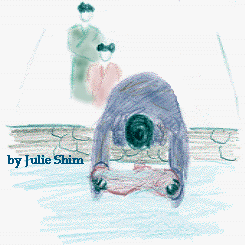Written by students of FC1750.06
at Founders College, York University
Vol.2, no. 3, June-August, 1997

A shocking image in The Silent Cry is Mitsu's portrayal of his friend's hanging corpse, "surely beyond all salvation" (4). The novel abounds with graphic details that depict the mutilation of the human body. Mitsu, for example, delves into a dream Taka has about the death of their brother, S. His "bare, smashed head" is likened to "a flat black bag with something red protruding from it," and before long Taka notices "a train of ants entering S's head" (71). Perhaps one of the most horrific images in The Silent Cry is Mitsu's description of Taka's body after he has committed suicide--"A man sprawled half-propped against the wall directly ahead. The skin of his face and bare chest was torn and bloody as though it were studded with split pomegranates" (243).
A Pale View of Hills does not center around the theme of violence and that is quite surprising considering the novel is set in Nagasaki, shortly after the 1945 atomic holocaust. Although it begins with the narrator's reminiscences of her daughter's suicide, the plot quickly moves away from grief and death to a story filled with unanswered questions about the mother's past and her friends, Sachiko and Mariko.
Noteworthy is the mystery woman Mariko keeps claiming to see around their house in Nagasaka at night. According to Sachiko, it is a phantom in her daughter's imagination since a heart-rending event in Tokyo during the Second World War. As the story goes, Mariko was upset about something one day and ran into the street. Her mother followed her into an alleyway until they reached a canal at the end of it. There was a woman kneeling in the canal with her arms submerged in the water up to her elbows. The woman turned to face Mariko and smiled at her. "I first I thought the woman was blind," Sachiko says. "She had that kind of look, her eyes didn't seem to actually see anything" (74). At this point one braces oneself to witness about how the woman was going to kill herself in front of Mariko and Sachiko. What happened next in the story is even more gripping. The woman brought her hands up out of the canal, cradling a baby. It is almost impossible to imagine the intensity of her agony as she was holding a beautiful baby in her arms under water and feeling the precious life fade from the child. What measure of pain and hopelessness that prompted the mother to perform such a sacrificial ritual is beyond comprehension.
Sachiko herself re-enacts such a tragedy when she drowns Mariko's kittens. We witness this scene through Etsuko's perspective. Sachiko holds one of the kittens in both hands, looks at it for a few seconds, and then glances up at the narrator. "It's just an animal, Etsuko," she said. "That's all it is" (167). If Sachiko didn't have a heart for the kittens, she could have killed them many other ways, yet she chooses to submerge them under water, just as the woman had done to her own child in the canal. Mariko watches without any visible expressions, reminding us of the woman at the canal, looking up and smiling at her with eyes that appeared sightless.
On the whole, Oe is blunt and realistic in dealing with issues of spirituality, the dark side of humanity, and the thin line between historical fact and myth. Ishiguro takes a more subtle approach. The death imagery in A Pale View of Hills is often associated with water, instilling a natural calm in the reader and having a damper effect on the harsh realities. The water imagery reflects the catharsis that Etsuko goes through as she tries to deal with her daughter's suicide and understand the phantoms from her past. Water cleanses the spirit and lessens her sense of guilt.
Bibliography
Ishiguro, Kazuo. A Pale View of Hills. London: Faber and Faber, 1982.
Oe, Kenzaburo. The Silent Cry. Trans. John Bester. London: Serpent's Tail, 1988 [1967].
Illustration by Julie Shim